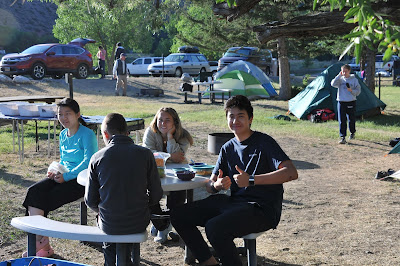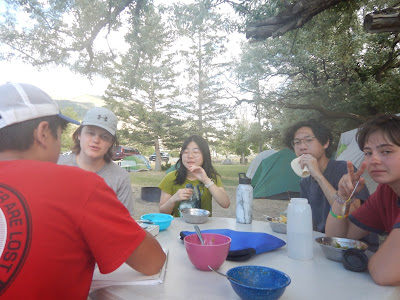Yellowstone Day 3
Written by Brayden Morse
6:30 AM MDT
We
woke up at 6:30 to get ready for the day. At 7:00 am, the Marmots group set up
everything for breakfast and lunch. They set out cereal, yoghurt, oatmeal, and
things to add to the breakfast foods. For lunch, they set out sandwich
ingredients. At 7:30, we ate and then around 7:45 the Pelicans group cleaned.
After everyone got ready, we played some games. We first introduced ourselves
to Meghan, a person from EPI who had joined us last night. Then we played
“Where the Wind Blows”, a game where a person in the middle says something
about themselves and, if it applies to you, you have to find a new spot. Then
we played “Where Is My Bison Duck?” where we had to take a bison rubber duck
from behind Sarah without her guessing who had it. Then we learned about Bison
in the gazebo. We learned how to distinguish between the sexes (males have a
longer beard, a penile tuft, and females have “wavier” horns). We also learned
of their history and how they teetered on extinction. At one point there were
only 325 bison in the United States! Lastly, we learned the basics of radio
telemetry, a system to find the approximate location of bison wearing collars
using a radio receiver.
9:30 AM MDT
We
set off for Yellowstone, specifically Lamar Valley, seeing 2 young black bears
on the way. Then we met Carly, a bison researcher who works in Yellowstone. She
taught us the specifics of radio telemetry, and we used it to get the general
direction of a bison. Unfortunately, due to the geometry of Lamar Valley it is
difficult to get a very accurate direction because the radio signal bounces off
of the many hills. Luckily, we got a signal and drove towards it. We didn’t
find the specific bison we were looking for, but we did find one with a collar.
We waited for the bison to move so we could gather some additional data. We set off in search for fresh poop! We formed a
line, calling out when we saw it. We stopped after finding 5 piles. We split
into 3 groups, using gloves and a spoon to make a bag with a spoonful from each
sample from each group. We take the fecal samples because they can be used to
investigate the diets of the bison and specifically the diet of that herd.
1:00 PM MDT
We
headed back to the cars to eat lunch. We asked Carly questions as we ate,
learning more about bison and what it was like to work in the field. After
that, we drove towards the same collared bison to take population numbers of the
herd. We stopped at a geological landmark, Soda Butte, to find the herd sitting
in a field near a river. We split the herd in half because the herd was too
large to accurately count all together. We took the data using binoculars and a
scope because some of the bison were close together, hidden, or laying down.
After that we said goodbye to Carly and headed towards Arch Park.
3:00 pm MDT
We
stopped at Arch Park we played “Ninja” and then we took down our combined data,
finding that there were 2 males, 30 females, 8 yearlings (bison who were around
1 year old), and 15 red-dogs (very young bison), totaling to 55 bison. Then we
headed back to camp.
5:20 pm MDT
We got back to
camp with 40 minutes of free time before the Marmots would cook jambalaya for
dinner. Cameron was feeling a little bold, so he decided to add Sriracha to the
already well-seasoned meal. He was crying (because of the dying bison, of
course). After eating, the Pelicans cleaned and the Marmots taught us about Yellowstone’s
volcanic activity. Under Yellowstone, starting at 2 miles below the surface, is
magma going down to 1800 miles. Due to the volcanic activity below Yellowstone,
the park raises about one inch each year. After that, we had free time.
10:00 pm MDT
Everyone went
to their tents, and some people were able to wake up at 11:45 to see the stars.
There was even a shooting star!






























No comments:
Post a Comment